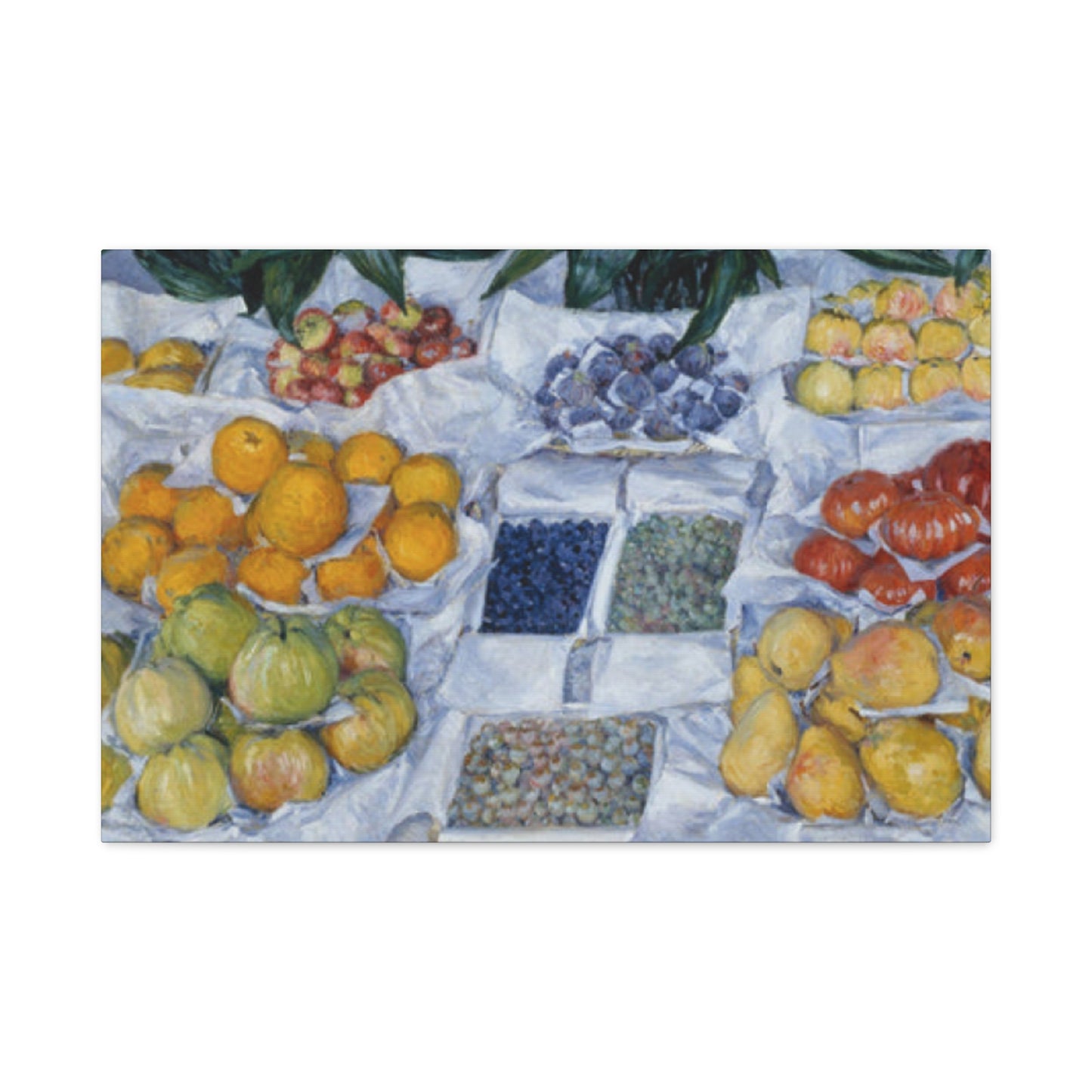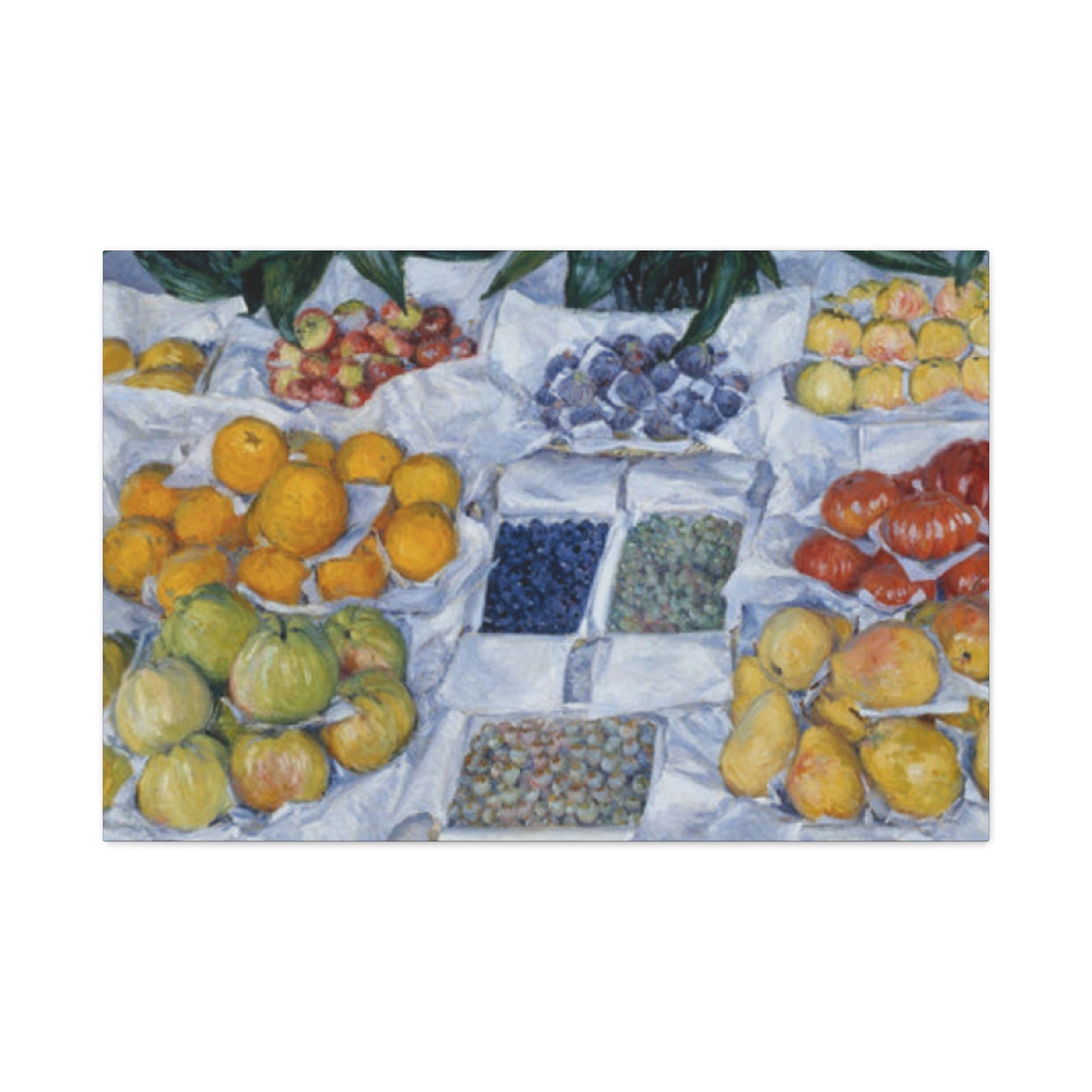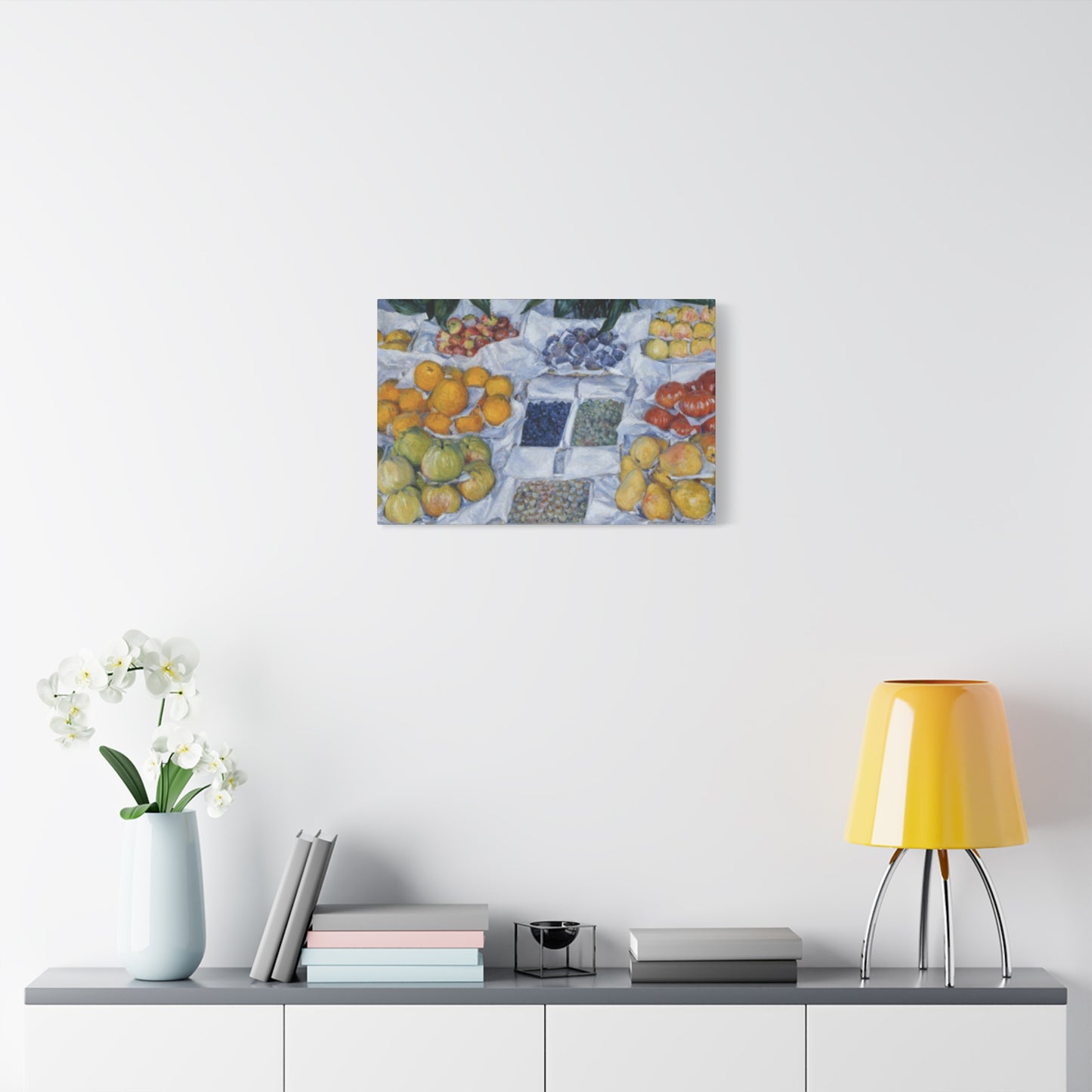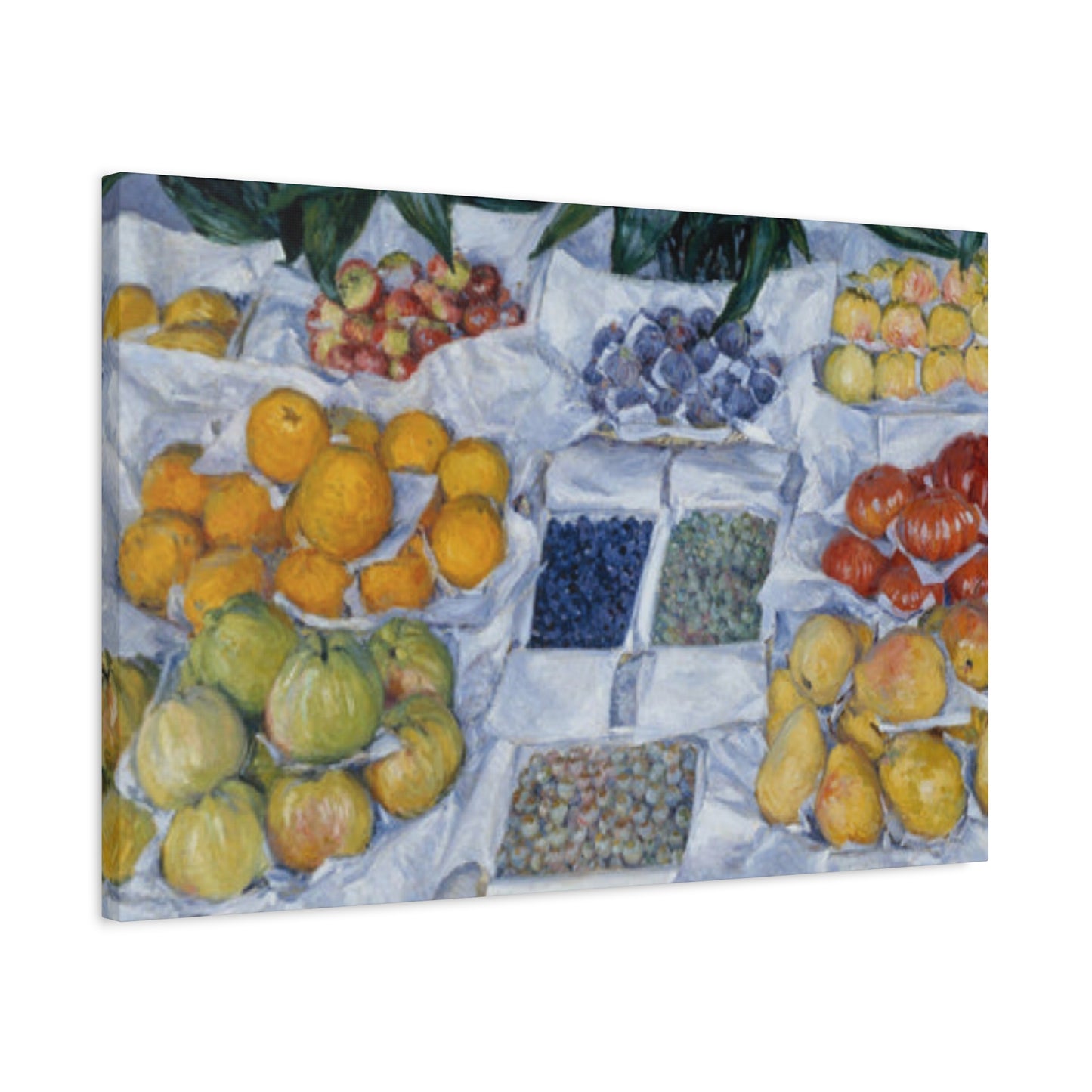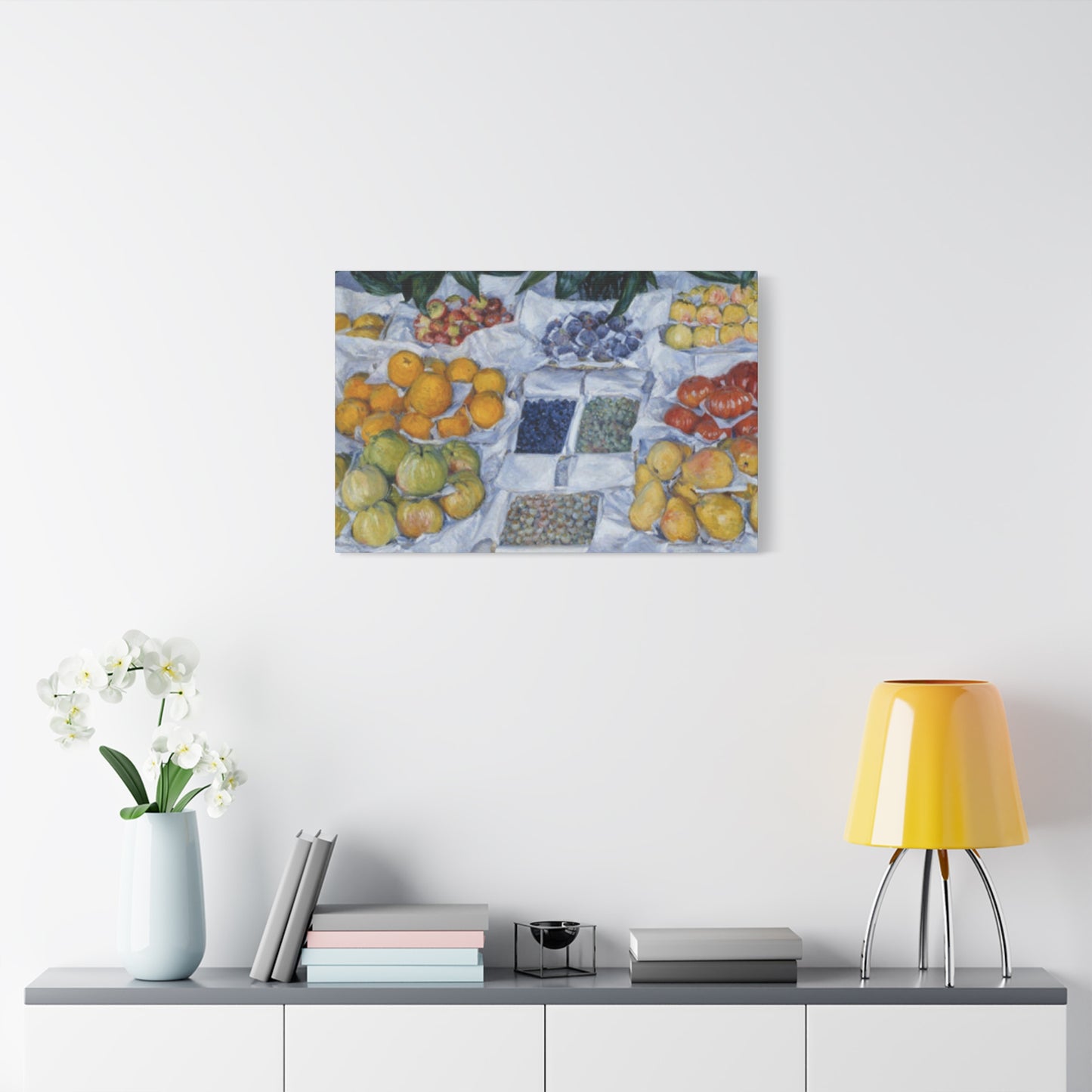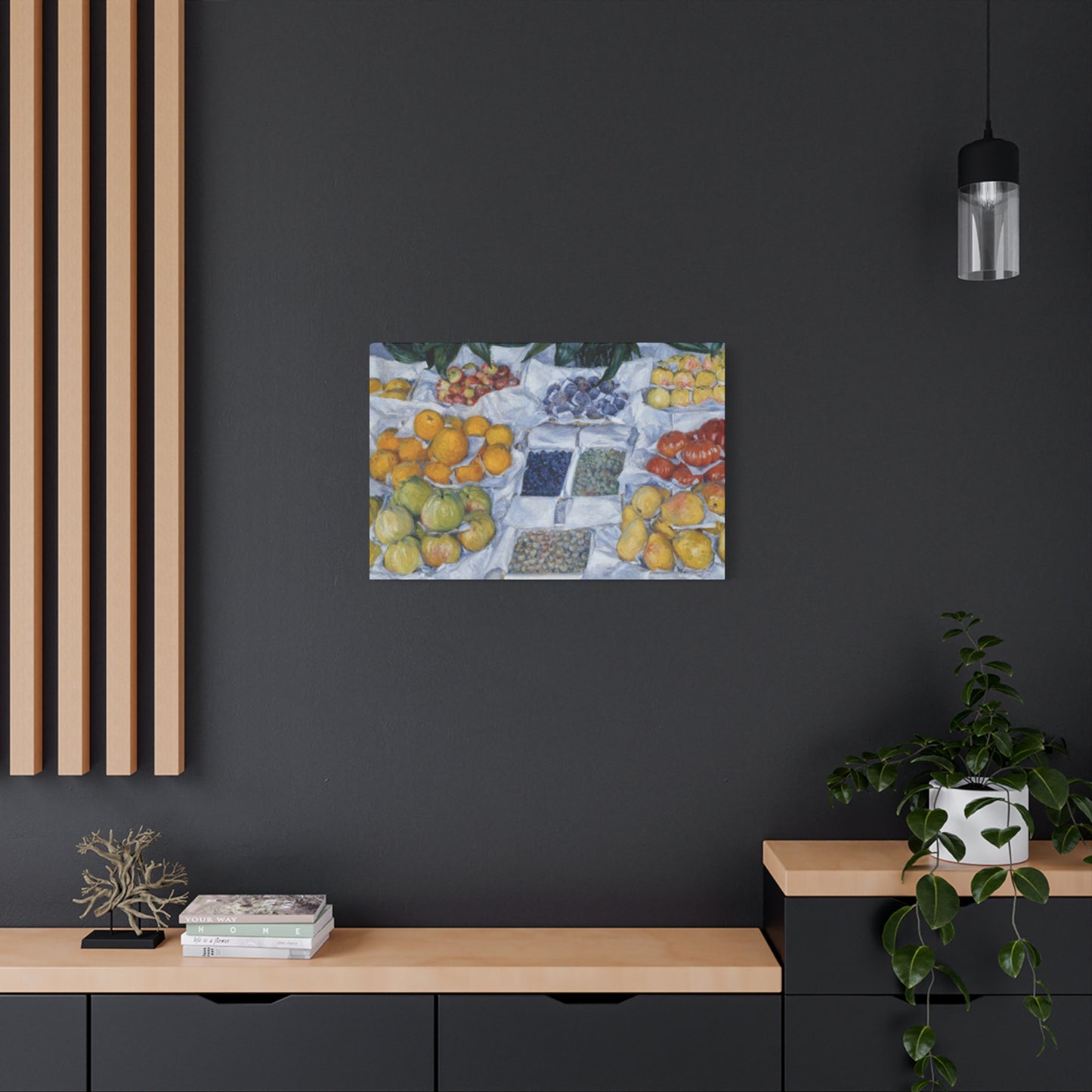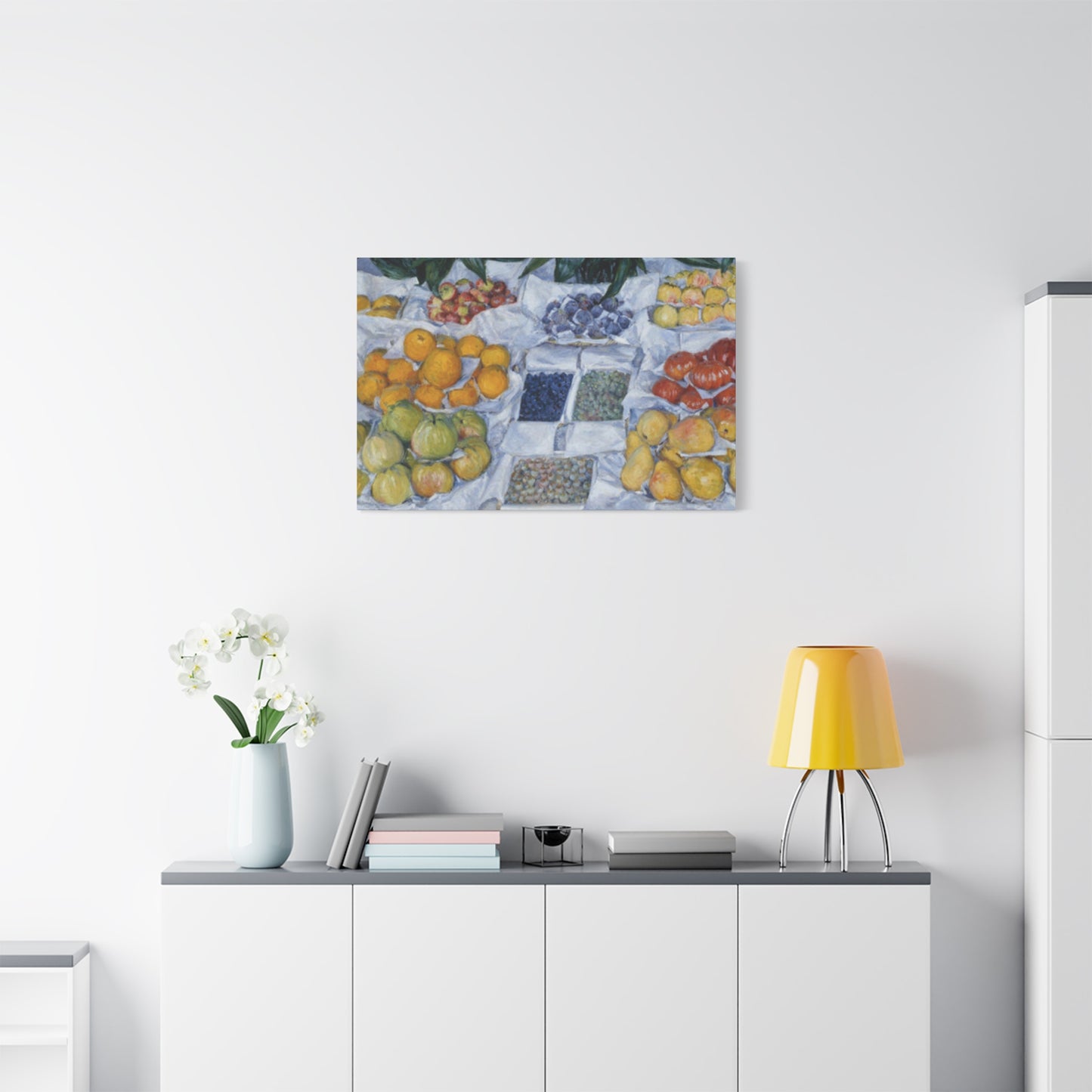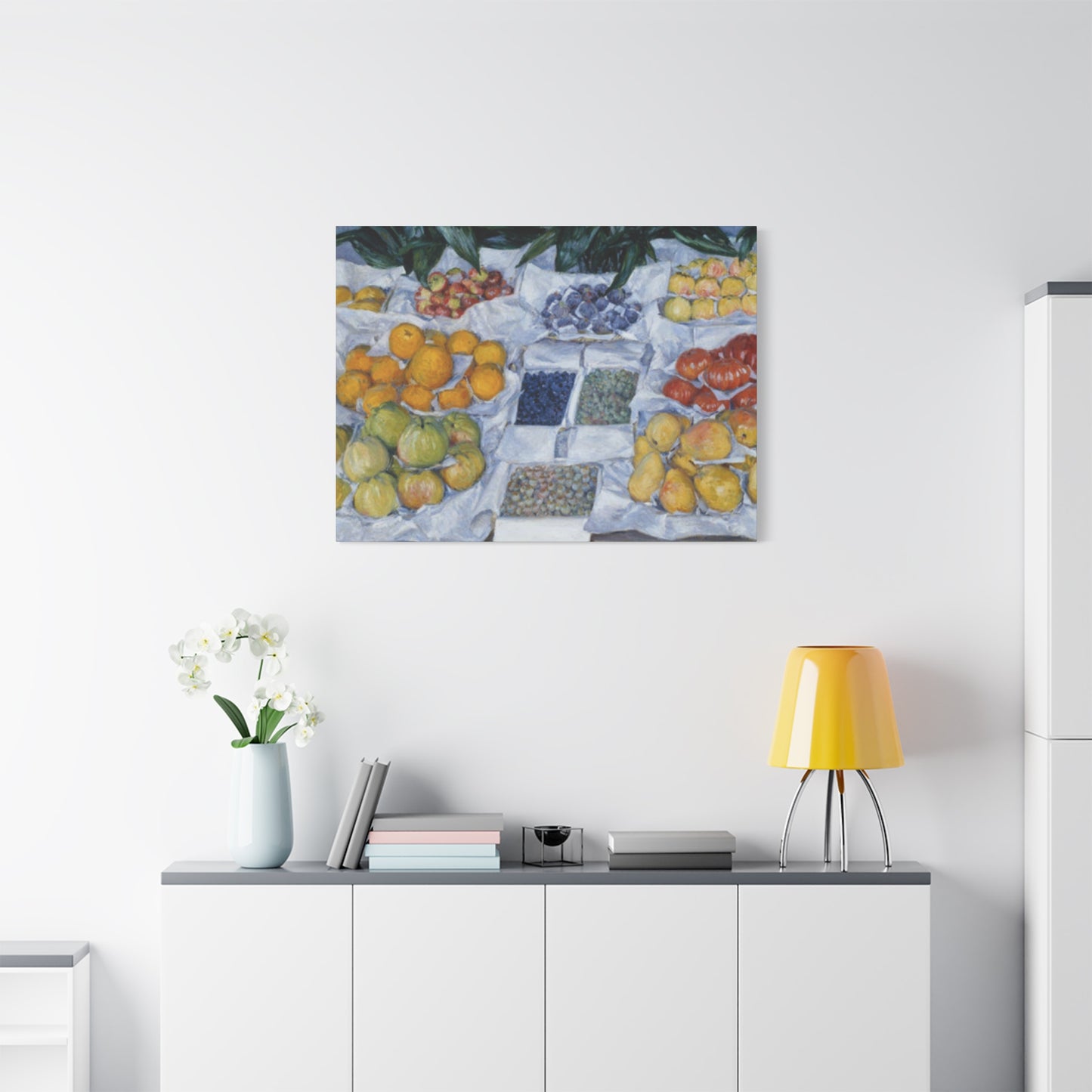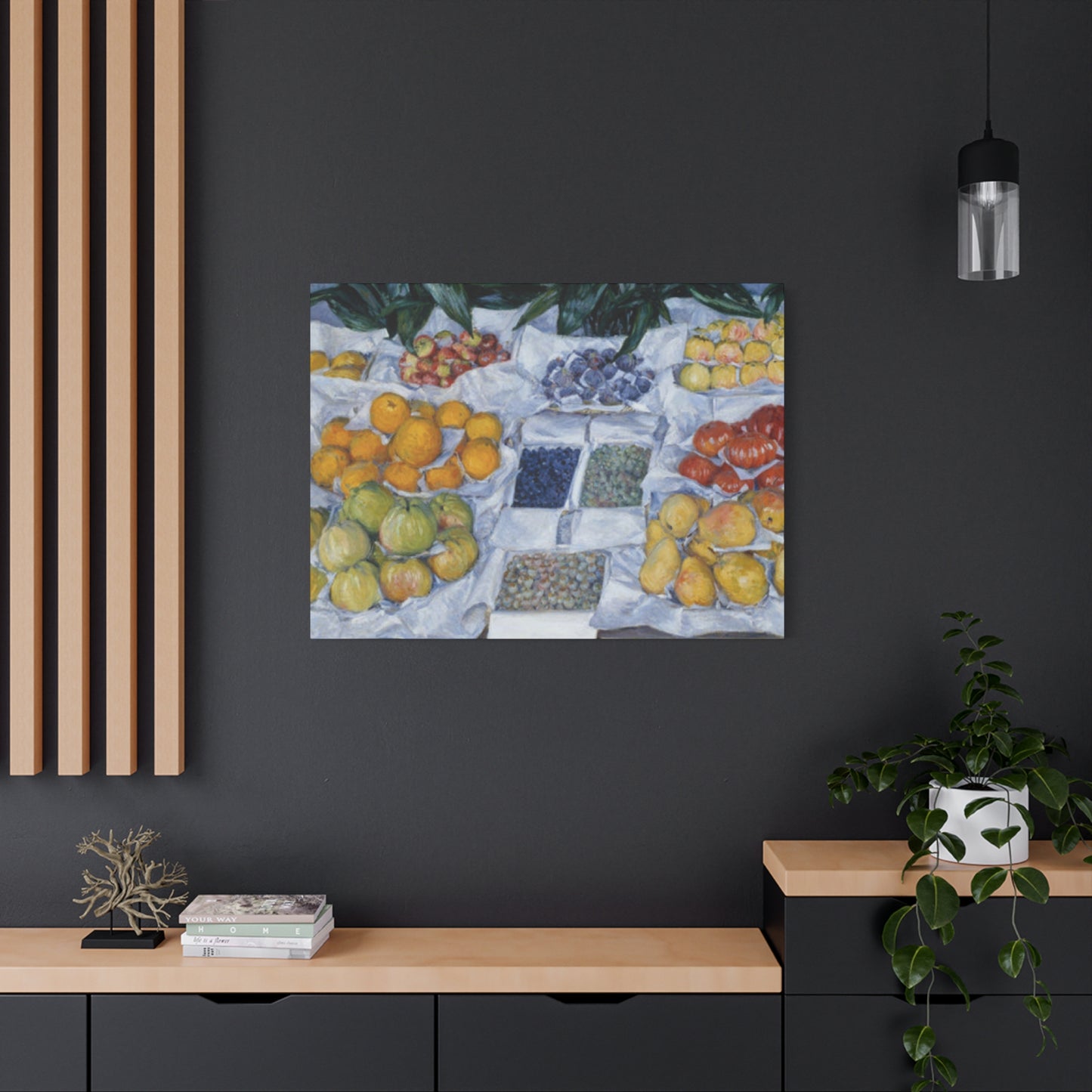Gustav's Fruit Wall Art: Bringing Nature's Beauty to Your Home
Gustav's mastery of color brings an extraordinary vibrancy to his fruit paintings that transforms any room into a celebration of nature's bounty. The artist's sophisticated understanding of color theory manifests through his deliberate selection of hues that capture the essence of ripe fruit at its peak perfection. Each brushstroke reveals a deep appreciation for the natural spectrum found in orchards and gardens, where sunlight dances across the surfaces of apples, pears, and citrus fruits.
The chromatic intensity in Gustav's work stems from his meticulous observation of how light interacts with fruit surfaces throughout different times of day. Morning light reveals cooler undertones in the shadows, while afternoon sun brings out the warm, golden highlights that make his painted oranges seem to glow from within. This attention to temporal lighting conditions creates paintings that seem alive with energy, as if the viewer could reach out and pluck the fruit directly from the canvas.
Gustav's color palette extends far beyond the obvious reds of apples or yellows of lemons. He incorporates subtle purples in grape clusters, deep burgundies in the shadows of cherries, and unexpected greens that appear in the reflected light between fruits. These sophisticated color choices demonstrate his understanding that fruit paintings must capture not just the object itself, but the entire environment in which it exists.
The psychological impact of Gustav's vibrant colors cannot be understated. Warm reds and oranges stimulate appetite and create feelings of comfort and abundance, making his fruit paintings particularly suitable for dining areas and kitchens. Meanwhile, the cooler greens and blues he employs in backgrounds provide visual balance and prevent the warmer tones from becoming overwhelming.
Contemporary homes benefit tremendously from Gustav's bold color choices, as modern neutral color schemes often lack the warmth and vitality that his fruit paintings provide. A single Gustav fruit painting can serve as the focal point around which an entire room's color scheme develops, with throw pillows, curtains, and other accessories drawing inspiration from the rich hues present in the artwork.
The longevity of Gustav's color choices ensures that his fruit paintings remain relevant across changing design trends. While fashion may dictate that certain colors come and go, the natural beauty of fruit transcends temporal preferences, making Gustav's work a timeless investment for art collectors and home decorators alike.
Still Life Excellence: Gustav's Fruit Art
The tradition of still life painting reaches its pinnacle in Gustav's fruit compositions, where technical mastery meets artistic vision to create works that celebrate the simple beauty of everyday objects. Gustav's approach to still life goes beyond mere representation, transforming ordinary fruit arrangements into profound meditations on form, color, and the passage of time.
Gustav's compositional genius reveals itself in how he arranges fruits within the picture plane. Rather than simply placing objects randomly, he considers the visual weight, color relationships, and symbolic meanings of each element. A single red apple might anchor an entire composition, while smaller fruits create rhythmic patterns that guide the viewer's eye through the painting. This careful orchestration demonstrates why Gustav's fruit art transcends decorative painting to become true artistic achievement.
The artist's understanding of negative space elevates his fruit still lifes above common commercial reproductions. Gustav recognizes that the areas between and around fruits are just as important as the fruits themselves. These spaces breathe life into the composition, preventing the crowded feeling that often plagues amateur still life work. The result is paintings that feel balanced and harmonious, suitable for long-term viewing in residential settings.
Technical excellence permeates every aspect of Gustav's fruit still life work. His brushwork varies according to the demands of each surface, with smooth, precise strokes for the glossy skin of apples contrasting with looser, more textured applications for the dimpled surface of oranges. This variation in technique creates visual interest while maintaining overall compositional unity.
Gustav's still life paintings often incorporate elements beyond fruit, including fabric drapery, ceramic vessels, and wooden surfaces that provide textural contrast and contextual richness. These additional elements never compete with the fruit for attention but rather enhance the overall narrative of abundance and natural beauty that characterizes his work.
The lighting in Gustav's still life compositions demonstrates his understanding of classical painting traditions while incorporating contemporary sensibilities. He employs dramatic chiaroscuro effects sparingly, preferring instead the soft, natural lighting that allows each fruit to maintain its individual character while contributing to the overall harmony of the piece.
Modern collectors appreciate Gustav's still life work for its ability to bring sophistication and cultural depth to contemporary living environments. These paintings reference centuries of artistic tradition while remaining accessible and appealing to viewers who may not have extensive art historical knowledge.
Using Fruit Paintings to Brighten Your Walls
The transformative power of Gustav's fruit paintings extends far beyond mere decoration, offering homeowners an opportunity to infuse their living environments with natural beauty, warmth, and sophisticated artistic sensibility. Strategic placement of fruit paintings can completely alter the mood and perceived atmosphere of any room, creating focal points that draw attention and inspire conversation.
Gustav's fruit paintings work exceptionally well in dining areas, where the subject matter naturally complements the room's function while the vibrant colors stimulate appetite and create an inviting atmosphere for meal sharing. The warmth of painted oranges and the richness of depicted grapes can make even simple family dinners feel more special and celebratory. Positioning a large Gustav fruit painting behind a dining table creates an instant focal point that anchors the entire room's design.
Kitchen environments benefit enormously from Gustav's fruit art, as these paintings bridge the gap between functional cooking areas and more formal living areas. The familiar subject matter feels appropriate in a kitchen setting while the artistic quality elevates the environment beyond purely utilitarian function. Smaller Gustav pieces can be grouped together to create interesting vignettes above countertops or near breakfast nooks.
Living rooms gain warmth and personality through the addition of Gustav's fruit paintings, particularly in contemporary homes where neutral color palettes might otherwise feel cold or sterile. The natural colors present in fruit paintings provide an organic warmth that synthetic color schemes often lack, while the subject matter remains universally appealing and non-controversial for guests with varying artistic tastes.
Hallways and transitional areas often lack personality due to their functional nature, but Gustav's fruit paintings can transform these overlooked areas into gallery-like experiences. A series of smaller fruit paintings arranged along a hallway creates visual interest and helps connect different areas of the home through consistent artistic themes.
The versatility of fruit paintings allows them to work effectively in both traditional and contemporary settings. In traditional homes, Gustav's work connects with historical still life traditions, while in modern environments, the same paintings provide organic softness that balances hard architectural elements and minimal furnishings.
Lighting considerations play a crucial role in maximizing the impact of Gustav's fruit paintings. Natural light brings out the subtleties in his color work, while artificial lighting should be carefully chosen to avoid color distortion. Track lighting or picture lights can highlight the paintings effectively while creating dramatic focal points during evening hours.
The Texture of Fruit in Gustav's Canvas Prints
Gustav's exceptional ability to capture and convey the varied textures of different fruits demonstrates his mastery of painting techniques and deep understanding of how visual texture contributes to the overall impact of artistic work. Each fruit variety presents unique textural challenges that Gustav meets with specific brushwork techniques and paint application methods that bring remarkable realism to his canvas prints.
The smooth, waxy surface of apples requires a completely different approach than the dimpled, porous skin of oranges or the fuzzy surface of peaches. Gustav's technical versatility shines through his ability to render these varied surfaces convincingly while maintaining consistent lighting and color relationships throughout each composition. This attention to textural accuracy creates paintings that engage viewers on multiple sensory levels, even though touch is obviously not involved in the viewing experience.
Canvas prints of Gustav's work successfully preserve the textural qualities of the original paintings through high-quality reproduction processes that capture the subtle variations in paint thickness and surface treatment. Modern printing technology allows these reproductions to maintain the visual impact of Gustav's original brushwork, making his art accessible to collectors who appreciate textural richness but may not be able to acquire original paintings.
The psychological impact of visual texture cannot be underestimated in Gustav's fruit paintings. Viewers respond instinctively to the implied tactile qualities of painted surfaces, with smooth, glossy apple skins suggesting crispness and freshness, while the rough texture of orange peels implies the tartness and juiciness hidden beneath. These textural cues activate memory and imagination, making the viewing experience more engaging and memorable.
Gustav's treatment of background textures provides important contrast and context for his fruit subjects. Smooth wooden table surfaces, rough burlap fabric, or polished ceramic vessels each receive careful attention that enhances rather than competes with the main fruit subjects. This hierarchical approach to texture ensures that viewers' attention remains properly focused while still appreciating the overall richness of each composition.
The reproduction quality of Gustav's canvas prints maintains textural fidelity that allows viewers to appreciate the artist's technical skill and attention to detail. High-resolution printing processes capture the subtle variations in paint application that create the illusion of different surface textures, ensuring that even reproductions maintain the visual impact of the original works.
Contemporary printing techniques have evolved to preserve not only the visual appearance of Gustav's textural work but also some of the physical dimensionality of the original paint application. This advancement means that canvas prints can offer viewers an experience much closer to viewing original paintings than was previously possible with standard reproduction methods.
Classic vs. Modern Styles in Fruit Art
The evolution of fruit art from classical traditions to contemporary interpretations reflects broader changes in artistic philosophy, technique, and cultural values, with Gustav's work representing a unique synthesis that honors traditional approaches while incorporating modern sensibilities. This balance makes his fruit paintings particularly relevant for today's art collectors and home decorators who appreciate both historical depth and contemporary appeal.
Classical fruit painting traditions emphasized symbolic meaning and technical perfection, with artists like Caravaggio and Chardin creating works that functioned as both aesthetic objects and moral or philosophical statements. Gustav's work acknowledges these traditions through his attention to compositional balance, lighting effects, and the careful selection of fruits that carry cultural and symbolic weight. However, his approach remains accessible to modern viewers who may not be familiar with traditional symbolic systems.
Modern approaches to fruit painting often emphasize abstraction, color theory, or conceptual content over realistic representation. Contemporary artists might deconstruct fruit forms into geometric shapes, explore color relationships through non-naturalistic palettes, or use fruit imagery to comment on consumer culture or environmental concerns. Gustav's work occupies a middle ground that maintains representational clarity while incorporating sophisticated color theory and compositional innovation.
The technical approaches that distinguish classical from modern fruit art reflect changes in both materials and artistic philosophy. Classical artists worked within established conventions for paint application, color mixing, and surface preparation, while modern artists often experiment with new materials, unconventional techniques, and mixed media approaches. Gustav's technique demonstrates mastery of traditional methods while incorporating innovations that enhance rather than disrupt the viewing experience.
Contemporary audiences often prefer Gustav's balanced approach because it provides the sophistication and cultural depth of classical art without requiring extensive art historical knowledge for appreciation. His paintings reward both casual viewing and serious study, making them suitable for diverse audiences and various home environments where different family members may have different levels of artistic interest.
The market for fruit art reflects this tension between classical and modern approaches, with collectors often seeking works that provide traditional beauty and craftsmanship while fitting comfortably in contemporary living environments. Gustav's paintings satisfy both requirements, offering the technical excellence associated with classical training and the visual appeal that works effectively with modern furnishings and architectural styles.
Interior decorators appreciate Gustav's synthesis of classical and modern elements because it provides flexibility in room design while ensuring long-term appeal. A painting that successfully combines traditional and contemporary elements is less likely to appear dated as design trends change, making it a wise investment for homeowners who plan to live with their art purchases for many years.
Framing Tips for Fruit Wall Art
The selection of appropriate framing for Gustav's fruit paintings significantly impacts both their visual effectiveness and their integration with surrounding home decor. Professional framing enhances the artwork while providing necessary protection, but the numerous options available can overwhelm homeowners who want to make the best choices for their particular situations and aesthetic preferences.
Traditional gold frames complement Gustav's classical painting techniques while emphasizing the richness of his color palette. Ornate gold moldings work particularly well with larger Gustav paintings where the frame's elaborateness balances the painting's visual weight. However, simpler gold frames can be equally effective with smaller works, providing warmth and elegance without overwhelming the artwork itself.
Contemporary homes often benefit from sleeker frame choices that complement modern furnishings while still honoring the artistic quality of Gustav's work. Black frames provide dramatic contrast that can make colors appear more vibrant, while natural wood frames create warmth and organic appeal that harmonizes with the fruit subject matter. The grain and color of wooden frames should complement rather than compete with the colors present in the painting.
Silver and metallic frame options offer sophisticated alternatives that work well in contemporary settings with cool color schemes. These frames provide elegance without the traditional associations of gold framing, making them suitable for homeowners who appreciate Gustav's artistic skill but prefer more modern presentation styles. Brushed metal finishes can add subtle texture that enhances without distracting from the painting's own textural qualities.
Matting decisions significantly affect the overall presentation of Gustav's fruit paintings. White or cream mats provide clean, classic presentation that works well with most frame styles and home decor schemes. However, colored mats can enhance specific colors within the painting or coordinate with room color schemes. The mat width should be proportional to both the painting size and the frame style, with larger paintings generally requiring wider mats for proper visual balance.
Glass selection involves considerations of both protection and presentation quality. Regular glass provides adequate protection for most home environments, while museum-quality glass reduces reflections and filters harmful UV light that can cause fading over time. Anti-reflective coatings improve viewing quality, particularly in rooms with large windows or bright artificial lighting that might otherwise create problematic reflections.
Professional consultation with experienced framers can help homeowners navigate the many technical and aesthetic decisions involved in properly presenting Gustav's fruit paintings. Quality framing represents an investment in both artwork preservation and home decor effectiveness, making professional guidance valuable for achieving optimal results that enhance both the artwork and the living environment.
Seasonal Fruit Themes in Gustav's Work
Gustav's artistic sensitivity to seasonal rhythms manifests beautifully in his fruit paintings, which capture not only the visual appearance of seasonal produce but also the emotional associations and cultural meanings that different fruits carry throughout the annual cycle. This seasonal awareness adds depth and relevance to his work, making it particularly meaningful for viewers who appreciate the connection between art and natural cycles.
Spring themes in Gustav's work often feature early fruits and blossoms that symbolize renewal and new beginnings. Cherry blossoms, early strawberries, and young pears appear in compositions that emphasize fresh greens and delicate pastels. These paintings bring the optimism and energy of spring into home environments, making them particularly effective in rooms where morning light emphasizes their fresh, clean colors.
Summer fruit paintings showcase the abundance and intensity of peak growing season, with rich reds of ripe tomatoes, deep purples of plums, and the golden yellows of summer peaches. Gustav's summer compositions often feature multiple fruit varieties arranged in ways that suggest overflowing baskets and bountiful harvests. The warm colors and abundant arrangements make these paintings perfect for dining areas where they can enhance the social and celebratory aspects of shared meals.
Autumn representations in Gustav's work capture the mature richness of harvest season through deep oranges, russet apples, and golden pears that echo the changing colors of fall foliage. These paintings often incorporate warmer lighting effects that suggest the golden hour light of autumn afternoons. The psychological associations of harvest and preparation for winter make these works particularly appealing for creating cozy, comfortable atmospheres in family living areas.
Winter fruit themes focus on preserved and citrus fruits that provide brightness during the darker months. Oranges, lemons, and preserved fruits appear in compositions that emphasize their role in providing color and nutrition during winter's scarcity. Gustav's winter fruit paintings often feature more dramatic lighting effects that suggest artificial illumination, making them effective for creating warmth and interest in rooms that receive limited natural light during winter months.
The seasonal rotation of Gustav's fruit paintings can provide homeowners with an engaging way to refresh their home decor throughout the year without major investment or renovation. Switching between seasonal fruit themes helps maintain visual interest while creating connections between indoor living areas and the natural world outside. This practice acknowledges the psychological benefits of maintaining awareness of seasonal cycles even in climate-controlled modern homes.
Gustav's understanding of seasonal symbolism extends beyond mere representation to encompass cultural and emotional associations that make his paintings more meaningful for long-term viewing. A spring fruit painting might inspire feelings of hope and renewal during difficult periods, while autumn harvest scenes can enhance feelings of gratitude and abundance during thanksgiving celebrations.
The Symbolism of Fruits in Wall Art
The rich symbolic traditions associated with different fruits add layers of meaning to Gustav's paintings that extend far beyond their surface beauty, creating artwork that functions both as decoration and as carriers of cultural and personal significance. Understanding these symbolic dimensions enhances appreciation for Gustav's careful selection and presentation of fruit subjects, revealing the thoughtful intention behind compositional choices.
Apples carry perhaps the most complex symbolic associations in Western culture, representing everything from temptation and knowledge to health and abundance. Gustav's apple paintings often emphasize the fruit's perfect form and rich coloring, suggesting positive associations with health, wisdom, and natural beauty rather than more problematic biblical connotations. The universal appeal of apple imagery makes these paintings suitable for diverse audiences and various home environments.
Grapes traditionally symbolize abundance, celebration, and spiritual transformation, making Gustav's grape paintings particularly appropriate for dining areas where they can enhance the social and celebratory aspects of shared meals. The clustering nature of grapes also suggests community and connection, adding social dimensions to rooms where people gather for conversation and companionship.
Citrus fruits like oranges and lemons carry associations with sunshine, energy, and purification, making Gustav's citrus paintings effective for bringing brightness and positive energy to darker rooms or areas that need visual stimulation. The bright colors and refreshing associations of citrus fruits make them particularly popular for kitchen and breakfast area decoration, where their energizing qualities support the room's functional purposes.
Pears traditionally represent longevity, wisdom, and feminine grace, with their elegant curves and subtle coloring suggesting sophistication and refinement. Gustav's pear paintings often work well in more formal areas of the home where their graceful associations complement elegant furnishings and decorative schemes. The organic curves of pears also provide visual softness that balances angular architectural elements.
Stone fruits like peaches and plums carry associations with sensuality, abundance, and the fleeting nature of beauty, adding philosophical depth to Gustav's paintings that feature these subjects. The soft, fuzzy texture of peaches and the deep colors of ripe plums create paintings that engage viewers on sensual levels while suggesting deeper meditations on time and pleasure.
Contemporary viewers may not be consciously aware of traditional fruit symbolism, but they often respond intuitively to these ancient associations. Gustav's skill lies in presenting fruit subjects in ways that activate these positive symbolic associations while avoiding negative connotations that might make viewers uncomfortable. This careful balance ensures that his paintings enhance rather than complicate the emotional atmosphere of home environments.
The layered symbolism in Gustav's fruit paintings makes them particularly suitable for gift-giving, as different fruits can be selected to convey specific messages or wishes. A painting featuring apples might suggest wishes for health and wisdom, while grape compositions could celebrate abundance and community connections.
Mixing Fruit Paintings with Kitchen Decor
The natural affinity between fruit imagery and kitchen environments creates numerous opportunities for integrating Gustav's paintings into culinary areas in ways that enhance both functionality and aesthetic appeal. The key lies in understanding how to balance artistic sophistication with practical considerations while creating cohesive design schemes that celebrate both food and art.
Color coordination between Gustav's fruit paintings and kitchen color schemes requires careful consideration of existing cabinet colors, countertop materials, and backsplash treatments. Warm fruit colors naturally complement traditional kitchen materials like wood cabinets and natural stone countertops, while the organic subject matter provides softness that balances harder surfaces and angular architectural elements. The key is selecting paintings that enhance rather than compete with existing color schemes.
Scale considerations become particularly important in kitchen environments where wall areas may be limited by cabinets, appliances, and functional requirements. Gustav's smaller fruit paintings can be grouped effectively to create visual impact without overwhelming limited wall areas, while single larger pieces can serve as dramatic focal points above breakfast bars or dining nooks integrated with kitchen areas.
Placement strategies should consider both viewing angles and practical concerns like heat, moisture, and cooking vapors that might affect artwork over time. Areas near stoves and sinks present challenges for art placement, while breakfast nooks and kitchen islands often provide ideal locations for fruit paintings that can be appreciated during meal preparation and consumption.
The psychological benefits of fruit imagery in kitchen environments extend beyond mere decoration to encompass the encouragement of healthy eating habits and positive associations with food preparation. Gustav's beautiful fruit paintings can inspire home cooks to pay greater attention to the visual presentation of their own culinary creations, elevating everyday meal preparation into more artistic endeavors.
Integration with functional kitchen elements requires creative approaches that honor both practical needs and artistic presentation. Gustav's fruit paintings can be incorporated into kitchen hutches, positioned above coffee stations, or arranged in breakfast nooks where they enhance the dining experience without interfering with cooking activities. The key is finding locations where the paintings can be properly appreciated while remaining safe from kitchen hazards.
Lighting considerations in kitchen environments must balance task lighting needs with artwork presentation requirements. Under-cabinet lighting can effectively illuminate fruit paintings positioned above countertops, while pendant lights over kitchen islands can highlight artwork while providing functional illumination for meal preparation activities.
The durability of canvas prints makes Gustav's fruit reproductions particularly suitable for kitchen environments where original paintings might be at risk from humidity, temperature changes, and cooking vapors. Quality reproductions can provide the same visual impact as originals while offering greater peace of mind in challenging environmental conditions.
Large-Scale Gustav Fruit Canvas Prints
The dramatic impact of large-scale Gustav fruit canvas prints transforms any environment into a gallery-like experience that celebrates both artistic excellence and natural beauty. These substantial artworks command attention while providing focal points that can anchor entire room designs and create memorable visual experiences for both residents and guests.
Architectural considerations become crucial when incorporating large Gustav fruit prints into home environments. High ceilings and open floor plans can accommodate substantial artworks that might overwhelm smaller, more intimate rooms. The scale relationship between artwork and architectural elements should create harmony rather than competition, with large prints working most effectively in areas where they can be viewed from appropriate distances.
The visual weight of large-scale fruit paintings requires careful consideration of surrounding furniture and decorative elements. Substantial artwork needs adequate visual support from appropriately scaled furniture pieces, while smaller decorative objects should be grouped or eliminated to prevent visual clutter that might diminish the painting's impact. The goal is creating environments where large artwork can be properly appreciated without creating overwhelming or unbalanced visual experiences.
Color relationships become more complex with large-scale artworks because the increased surface area means that colors have greater influence on room atmosphere. Gustav's masterful color handling ensures that even his largest fruit compositions maintain proper balance and harmony, but homeowners should consider how these expanded color fields will interact with existing room color schemes and natural lighting conditions throughout different times of day.
Installation requirements for large canvas prints demand professional attention to ensure both proper presentation and long-term stability. Substantial artwork requires appropriate hanging hardware and wall anchoring systems that can safely support considerable weight while maintaining proper positioning. Professional installation ensures that valuable artwork remains secure while achieving optimal viewing angles and lighting conditions.
The investment value of large-scale Gustav reproductions makes them particularly attractive for homeowners who want significant artistic impact without the cost of comparably sized original paintings. Quality large-format printing technology can reproduce Gustav's work with exceptional fidelity, providing visual experiences very close to viewing original paintings while making sophisticated art accessible to broader audiences.
Room design considerations must account for the dominant presence of large-scale artwork in planning furniture arrangements, lighting schemes, and traffic patterns. Large Gustav fruit prints can determine entire room layouts, with furniture positioned to create optimal viewing experiences while maintaining comfortable circulation patterns for daily living activities.
The emotional impact of large-scale fruit imagery creates powerful positive associations that enhance daily living experiences. Gustav's skill in creating inviting, abundant fruit compositions translates into room atmospheres that feel welcoming and luxurious when presented at substantial scales that allow viewers to become immersed in the artistic experience.
Abstract Fruit Art Inspired by Gustav
The evolution from Gustav's representational fruit paintings toward more abstract interpretations opens exciting possibilities for contemporary audiences who appreciate both traditional artistic skill and modern aesthetic innovation. These abstract approaches maintain connections to Gustav's original vision while exploring new ways of expressing the essential qualities that make fruit subjects compelling.
Color abstraction represents one of the most successful approaches to developing Gustav-inspired fruit art that moves beyond literal representation. By isolating and emphasizing the color relationships present in Gustav's original work, contemporary artists can create compositions that capture the emotional and psychological impact of fruit imagery without requiring detailed representational elements. These color-focused works often prove more versatile for contemporary home decor while maintaining connections to Gustav's artistic vision.
Form abstraction takes Gustav's understanding of fruit shapes and reduces them to essential geometric or organic forms that suggest rather than explicitly depict fruit subjects. These simplified forms can create sophisticated compositions that work effectively in modern architectural environments while retaining enough connection to fruit imagery to activate the positive associations that make Gustav's work so appealing.
Texture abstraction focuses on the varied surface qualities that Gustav captured so skillfully in his representational work, translating these textural elements into abstract compositions that engage viewers through tactile suggestions rather than recognizable imagery. These texture-focused works often prove particularly effective as large-scale statements that can provide visual interest and sophisticated atmosphere without the literal associations of representational art.
Contemporary printing techniques enable the creation of abstract fruit art that maintains high production values while exploring experimental approaches inspired by Gustav's work. Digital manipulation of Gustav's original compositions can yield abstract variations that honor the source material while creating entirely new aesthetic experiences suitable for diverse contemporary settings.
The market for abstract fruit art inspired by Gustav serves collectors who appreciate the emotional and aesthetic qualities of his work but prefer more contemporary presentation styles. These pieces can provide sophisticated artistic content for modern homes while maintaining the warmth and positive associations that make fruit imagery universally appealing.
Mixed media approaches combine Gustav's fruit imagery with contemporary materials and techniques to create hybrid works that bridge traditional and modern aesthetic sensibilities. These experimental pieces often incorporate elements like metallic accents, dimensional components, or unconventional printing surfaces that add contemporary relevance while honoring Gustav's original artistic achievements.
The philosophical implications of abstract fruit art extend Gustav's work into contemporary conversations about representation, perception, and the role of traditional subjects in modern artistic expression. These abstract interpretations can engage viewers who might dismiss representational fruit art as overly traditional while still providing the positive psychological benefits associated with natural imagery.
Gifts Featuring Gustav's Fruit Paintings
The universal appeal of Gustav's fruit paintings makes them exceptional gifts that can celebrate relationships while introducing recipients to sophisticated artistic experiences. The positive associations of fruit imagery combined with Gustav's masterful execution creates gift opportunities suitable for diverse occasions and recipient personalities, from art enthusiasts to practical homemakers who simply appreciate beautiful things.
Wedding gifts featuring Gustav's fruit paintings can symbolize abundance, fertility, and the sweetness of new relationships while providing couples with sophisticated artwork that enhances their first homes together. Fruit imagery carries traditional associations with prosperity and happiness that make these paintings particularly meaningful for celebrating new marriages and wishing couples well for their future together.
Housewarming gifts often pose challenges because givers must select items suitable for unknown decorating schemes and personal tastes. Gustav's fruit paintings solve this dilemma through their universal appeal and neutral subject matter that works effectively with diverse home decor styles. The natural beauty of fruit transcends specific design trends, making these paintings safe choices for gift-givers while still demonstrating thoughtfulness and good taste.
Anniversary celebrations gain special meaning through Gustav fruit paintings that can commemorate years of shared growth and abundance. Different fruits can be selected to represent specific anniversary themes or personal memories, while the artistic quality ensures that these gifts will be treasured and displayed prominently rather than stored away like many conventional anniversary presents.
Business gifts require careful navigation between personal and professional appropriateness, making Gustav's fruit paintings ideal choices that demonstrate sophistication without becoming overly intimate. The classical nature of fruit still life art carries cultural gravitas that impresses clients and business associates while remaining suitable for office display and professional environments.
Holiday gift-giving often relies on seasonal themes that make Gustav's fruit paintings particularly relevant. Autumn fruit compositions work beautifully for Thanksgiving celebrations, while citrus paintings can brighten winter holiday seasons. The seasonal associations add meaning while the artistic quality ensures long-term appreciation that extends well beyond specific holiday seasons.
Retirement gifts should celebrate new freedom while acknowledging life experience and accumulated wisdom. Gustav's fruit paintings work perfectly for retirees who may finally have time to appreciate artistic beauty while the mature sophistication of still life art honors their life achievements and cultivated taste. These paintings can help retirees create beautiful home environments for their increased leisure time.
The presentation of Gustav fruit painting gifts can be enhanced through thoughtful framing choices and accompanying materials that demonstrate the giver's attention to detail and appreciation for the recipient's taste. Professional presentation elevates these gifts from simple purchases to carefully considered artistic offerings that honor both the artwork and the recipient.
How to Care for Fruit Wall Art Prints
Proper care and maintenance of Gustav's fruit canvas prints ensures their long-term beauty while protecting the investment that these quality reproductions represent. Understanding the specific requirements for canvas print preservation helps homeowners enjoy their artwork for decades while maintaining the vibrant colors and sharp details that make Gustav's work so appealing.
Environmental considerations play crucial roles in canvas print longevity, with temperature and humidity control being particularly important factors. Extreme temperature fluctuations can cause canvas materials to expand and contract, potentially leading to cracking or loosening of the canvas surface. Moderate, stable temperatures between 65-75 degrees Fahrenheit provide optimal conditions for canvas preservation, while humidity levels should remain between 45-55% to prevent both excessive drying and moisture absorption.
Lighting protection represents one of the most critical aspects of canvas print care, as ultraviolet radiation can cause significant color fading over time. Direct sunlight should be avoided completely, while even indirect sunlight can cause gradual color changes that diminish the visual impact of Gustav's carefully crafted color relationships. UV-filtering window treatments can help protect artwork in sunny rooms, while artificial lighting should use LED or other low-UV sources positioned to avoid direct heat exposure.
Dust accumulation poses ongoing challenges for canvas print maintenance, requiring regular but gentle cleaning to maintain visual clarity without damaging the print surface. Soft, clean brushes or microfiber cloths can remove surface dust effectively when used with light, careful strokes that follow the canvas texture rather than working against it. Vacuum cleaners with brush attachments can be used cautiously for more thorough cleaning, but care must be taken to avoid sucking the canvas surface or pulling it away from its mounting system.
Chemical exposure from cleaning products, air fresheners, and household pollutants can cause gradual deterioration of canvas prints over time. Kitchen installations require particular attention because cooking vapors, grease particles, and steam can accumulate on artwork surfaces and cause staining or deterioration. Regular gentle cleaning becomes even more important in these environments, while adequate ventilation helps minimize exposure to harmful substances.
Storage considerations become important when canvas prints need to be temporarily removed for moving, renovation, or rotation with other artwork. Flat storage in clean, dry conditions provides optimal preservation, while rolling should be avoided if possible because it can cause creasing or cracking of the print surface. When rolling becomes necessary, it should be done around large-diameter tubes with the printed surface facing outward to minimize stress on the ink layer.
Professional conservation services can address more serious damage or deterioration that exceeds the scope of routine home care. Water damage, tears, or significant fading may require expert attention to restore prints to acceptable condition. However, prevention through proper care remains far more cost-effective than restoration, making routine maintenance practices essential for long-term artwork preservation.
The documentation of condition and care history helps maintain the value and integrity of Gustav fruit canvas prints over time. Photographing the artwork periodically can help track any changes, while maintaining records of cleaning, environmental conditions, and any professional services creates valuable information for insurance purposes and future care decisions.
DIY Fruit Painting Projects Inspired by Gustav
The inspiration derived from Gustav's masterful fruit paintings can motivate amateur artists and craft enthusiasts to create their own fruit-themed artwork that brings personal creativity into home decoration while honoring the traditions that make Gustav's work so compelling. These DIY projects offer opportunities for artistic expression while developing appreciation for the technical skill evident in professional artwork.
Beginner watercolor projects provide accessible entry points for creating Gustav-inspired fruit art without requiring extensive artistic training or expensive materials. Simple fruit shapes can be painted using basic watercolor techniques that emphasize color blending and wet-on-wet effects similar to those Gustav employs in his professional work. The transparency and fluidity of watercolors naturally complement fruit subjects while allowing beginners to experiment with color relationships and compositional arrangements.
Acrylic painting projects offer more control and forgiveness for novice artists who want to create Gustav-inspired fruit art with greater precision and detail. The opaque nature of acrylic paints allows for corrections and layering techniques that can help beginners achieve more finished-looking results while learning fundamental skills like color mixing, brushwork, and compositional balance that characterize Gustav's professional approach.
Mixed media approaches combine traditional painting techniques with collage, texture elements, and found materials to create contemporary interpretations of Gustav's fruit themes. These projects can incorporate fabric scraps, textured papers, or dimensional elements that add tactile interest while maintaining connections to fruit imagery. The experimental nature of mixed media work encourages creative problem-solving while reducing pressure for technical perfection.
Digital art projects using tablets and stylus tools provide modern approaches to creating Gustav-inspired fruit art that can be easily shared, reproduced, and modified. Digital painting software offers unlimited color palettes and the ability to experiment freely without material costs or cleanup requirements. These tools can help beginners understand color theory and composition principles while creating finished artwork suitable for home decoration.
Print-making techniques like linocut or screen printing can transform simple fruit designs into multiple copies suitable for gift-giving or creating coordinated series for home decoration. These processes require planning and careful execution that can deepen appreciation for the artistic decisions involved in creating effective fruit imagery while producing finished works with distinctive handmade character.
Photography projects focusing on real fruit arrangements can develop understanding of the lighting, composition, and color relationships that make Gustav's paintings so effective. Creating and photographing fruit still life arrangements helps artists understand the three-dimensional relationships and lighting effects that professional painters must translate into two-dimensional compositions. These photographic studies can serve as reference material for painted works or stand alone as contemporary interpretations of still life traditions.
The educational value of DIY fruit art projects extends beyond mere craft activity to encompass art history, color theory, and aesthetic appreciation that can enhance understanding and enjoyment of professional artwork like Gustav's paintings. These hands-on experiences create deeper connections with artistic traditions while providing personal creative satisfaction and home decoration opportunities.
The Role of Light and Shadow in Fruit Art
Gustav's masterful handling of light and shadow transforms simple fruit subjects into compelling artistic statements that demonstrate his understanding of how illumination affects both visual perception and emotional response. The interplay between light and shadow creates depth, volume, and atmosphere that elevates his fruit paintings above mere representation into sophisticated artistic achievements that reward careful viewing.
Directional lighting in Gustav's compositions reveals his understanding of classical painting traditions where single light sources create dramatic modeling effects that emphasize three-dimensional form. The careful placement of highlights on fruit surfaces suggests their roundness and texture while cast shadows anchor objects to their supporting surfaces and create spatial relationships between different elements within the composition.
The quality of light in Gustav's fruit paintings varies according to his artistic intentions and the mood he wishes to create. Soft, diffused lighting suggests gentle, natural illumination that creates peaceful, contemplative atmospheres, while stronger, more directional light creates dramatic contrasts that energize compositions and draw attention to specific elements. This variation in lighting quality allows Gustav to control the emotional impact of his paintings while maintaining technical consistency.
Color temperature considerations demonstrate Gustav's sophisticated understanding of how different types of light affect color perception and emotional associations. Warm light enhances the reds and yellows in fruit subjects while creating cozy, intimate atmospheres, while cooler light emphasizes blues and greens while creating more formal, refined moods. Gustav's skill in manipulating color temperature through paint allows him to suggest specific lighting conditions and their associated emotions.
Conclusion
Gustav’s fruit wall art beautifully captures the essence of nature’s bounty, transforming everyday interiors into vibrant, artful spaces. Inspired by the natural beauty of fruits and Gustav’s signature artistic style, these pieces bring life, color, and organic charm to your walls. Whether it’s a single bold fruit on canvas or a detailed arrangement rich with texture and symbolism, Gustav’s art infuses your home with warmth and personality.
Fruit has long been a symbol of abundance, vitality, and nourishment—not just physically, but visually and emotionally. Gustav’s interpretation takes that symbolism a step further, using rich colors, expressive brushstrokes, and detailed compositions to celebrate the beauty of the natural world. His fruit wall art is more than décor; it’s a statement of appreciation for life’s simple, yet meaningful pleasures.
Perfect for kitchens, dining rooms, or cozy reading corners, Gustav’s fruit-themed pieces blend well with both rustic and modern interiors. Their timeless aesthetic makes them adaptable to a variety of styles—from farmhouse to contemporary—while their bold color palettes can serve as both focal points and complementary accents in a neutral or colorful setting.
Ultimately, incorporating Gustav’s fruit wall art into your home is a way to celebrate nature, artistry, and the joy found in everyday moments. It brings a fresh, organic touch indoors, reminding us to slow down and savor beauty in its simplest forms. With each piece, you’re not just decorating a wall—you’re adding life, story, and a piece of the natural world to your personal space.


















